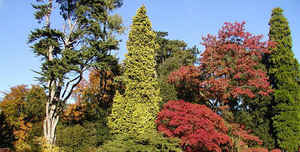Arizona State Tree
Palo Verde

(Parkinsonia florida)
(Parkinsonia microphylla)
GENERA
(Cercidium updated to Parkinsonia)
Adopted in 1954.
The Palo Verde Tree (Genera Cercidium) was selected by the Legislature as the official state tree of Arizona in 1954. The Arizona House of Representatives approved House Bill No. 227 on March 23, 1954 and the Senate followed suit on April 3, 1954.
Governor John Howard Pyle signed this legislation less than a week later on April 9, 1954. The original legislation refers to the genus Cercidium. The genus has been updated to Parkinsonia. There are two species that are native to Arizona and these are the varieties listed below. They are Parkinsonia florida, commonly referred to as the blue palo verde and Parkinsonia microphylla, commonly referred to as the yellow palo verde.
Arizona State Tree: Blue Palo Verde

Palo Verde is from the Spanish meaning "green stick" or "green pole." It is found in the desert and desert foothill regions of Arizona.
When the Palo Verde tree blooms, either in April or May depending on the elevation, it is a blaze of shimmering yellow-gold. Two species are native to Arizona: the Blue Palo Verde and the Foothill Palo Verde which is yellow-green.
Both the Blue and Foothill Palo Verdes have a number of characteristics in common, starting with the reason they are called Palo Verdes (Spanish for green stick). The name indicates that these trees can use the chlorophyll in their bark to photosynthesize and produce sugar. In general, three quarters of their food is metabolized through the bark, whereas only a quarter is produced by the leaves.
Identification of the Blue Palo Verde (Parkinsonia florida)
Leaf: Alternate, bipinnately compound, usually with only 2 major leaflets each about 1/2 inch long, blue-green and short lived.
Flower: Loose clusters of bright yellow flowers with 5 lobes, entire flower 3/4 inch across, appearing in spring and early summer.
Fruit: Two to 3 inch flat legume, light brown, mature in the summer and drop quickly.
Twig: Slender, blue-green and smooth, straight spine at base of leaf.
Bark: Initially smooth and green, later turning light brown and a bit scaly.
Form: Short tree (up to 30 feet tall) with a crooked trunk and a wide spreading crown with many fine branches, leafless for much of the year.
Identification of the Yellow Palo Verde (Parkinsonia microphylla)
Leaf: Alternate, bipinnately compound, with only 2 major leaflets making it appear as a pair of pinnately compound leaves, each about 1/2 inch long, green and short lived.
Flower: Loose clusters of bright yellow flowers with 5 lobes, entire flower 1/2 inch across, appearing in spring and early summer.
Fruit: Two to 4 inch cylindrical legume swollen at seeds, sharply pointed at ends, light brown, matures in the summer, persist on the tree.
Twig: Slender to moderately stout, yellow-green, smooth, each short twig ending in a sharp point.
Bark: Initially smooth and yellow-green, later turning light brown and a bit scaly.
Form: Large shrub or small tree (up to 25 feet tall) with a crooked trunk and a wide spreading crown with many fine branches, leafless for much of the year.
Arizona House Bill 227
State of Arizona
House of Representatives
Twenty-First Legislature
Second Regular Session
H. B. 227
Introduced by Mrs. Thode of Pinal; Mrs. Anderson of Cochise; Mrs. Rosenbaum of Gila; Mesdames Burgess, Dwyer, Haberl, Kuntz, McRae of Maricopa; Mesdames
Hutcheson, Willis of Pima; Mrs. Ellis of Yavapai.
AN ACT
ADOPTING THE PALO VERDE (GENERA CERCIDIUM) AS THE STATE TREE.
Be it enacted by the Legislature of the State of Arizona:
Section 1. STATE TREE. The Palo Verde (genera cercidium) shall be the state tree of Arizona
Taxonomic Hierarchy: Blue Palo Verde
Kingdom: Plantae - Plants
Subkingdom: Tracheobionta - Vascular plants
Superdivision: Spermatophyta - Seed plants
Division: Magnoliophyta - Flowering plants
Class: Magnoliopsida - Dicotyledons
Subclass: Rosidae
Order: Fabales
Family: Fabaceae ⁄ Leguminosae - Pea family
Genus: Parkinsonia L. - paloverde
Species:
Parkinsonia florida (Benth. ex A. Gray) S. Watson - blue paloverde
Parkinsonia microphylla - yellow paloverde








